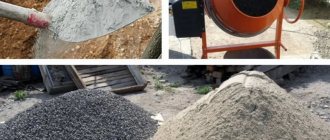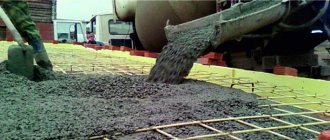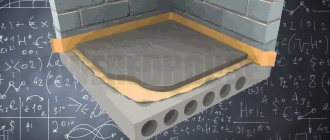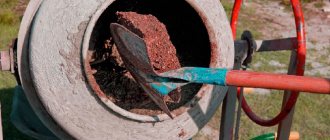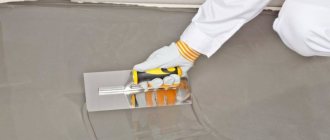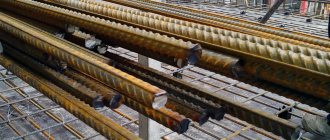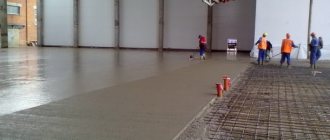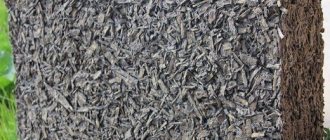The adhesion of cement to various substrates (surfaces) is an important technical characteristic that determines the following capabilities. In particular: the ability of cement to hold concrete filler elements, the ability of cement plaster to “stick” and remain for a long time on wall surfaces made of different materials.
It is also the ability of cement-based glue to “stick” finishing and thermal insulation materials (artificial stone, ceramic tiles, polystyrene foam, basalt wool, etc.) to brick, concrete, foam block, wood and other bases.
Technical meaning of adhesion
The word “Adhesion” translated from Latin means “sticking”. This refers to the adhesion of dissimilar or homogeneous materials to each other. In our case, we consider the “adhesion” of cement-based solutions: concrete, plaster, masonry mortar, repair compounds, glue, and other building materials.
There are three types of adhesion:
- Physical. Adhesion occurs at the molecular level. An example is the adhesion of a magnet to a steel base.
- Chemical. Adhesion occurs at the atomic level. An example is welding and soldering parts. Also, the adhesion of a dental filling to the dental pulp has a chemical meaning.
- Mechanical. The adhesion of materials occurs due to the penetration of the adhesive (plaster, concrete mortar, masonry mortar, glue, etc.) into the pores and roughness of the base. Example: plastering, tiling, painting.
The degree of adhesion is measured in MPa. The numerical value indicates the amount of force that must be applied to tear the adhesive away from the base. For example, on the packaging of the dry plaster mixture “ECO 44” it is indicated that the minimum adhesion of this material to the base is 0.5 MPa. This means that in order to tear off the adhesive layer from the base, you need to apply a force of 5 kg per 1 cm2 of area.
The degree of adhesion of the material to the base varies depending on the type and age of the base. For example, old concrete has a degree of adhesion to new concrete from 0.9 to 1.0 MPa, while modern dry building mixtures can provide a degree of “adhesion” of up to 2 MPa or more.
Laboratory testing of the degree of adhesion of dry building mixtures is carried out on special samples, in accordance with the requirements of GOST 31356-2007.
How to increase cement adhesion
Using a cement mixture, it is possible to level and plaster walls, seal all kinds of holes, etc. At the same time, builders often face the problem of improving the adhesion of the cement mixture.
The adhesion of cement to various substrates (surfaces) is an important technical characteristic that determines the ability of cement to hold concrete filler elements, the ability of cement plaster to “stick” and remain for a long time on wall surfaces made of different materials.
It is also the ability of cement-based glue to “stick” finishing and thermal insulation materials (artificial stone, ceramic tiles, polystyrene foam, basalt wool, etc.) to brick, concrete, foam block, wood and other bases.
Translated from Latin, “adhesion” means “sticking.” This refers to the adhesion of dissimilar or homogeneous materials to each other, in this case the “sticking” of cement-based solutions: concrete, plaster, masonry mortar, repair compounds, glue, etc.
In the case of mechanical adhesion, the adhesion of materials occurs due to the penetration of the adhesive (plaster, concrete mortar, masonry mortar, glue, etc.) into the pores and roughness of the base.
The degree of adhesion is measured in MPa and indicates the amount of force that must be applied to pull the adhesive away from the substrate.
The degree of adhesion of the material to the base varies depending on the type and age of the base.
The degree of “sticking” of the adhesive to the base depends on the cleanliness and roughness of the surface and shrinkage processes. As the adhesive shrinks, stresses arise, causing cracking and peeling from the substrate.
How to increase adhesion (improve adhesion) of cement mortar
It is necessary to prepare the surface by thoroughly cleaning it from contaminants: dust, grease stains, amorphous masses, etc. All irregularities must be eliminated. Alternatively, you can simply apply a thin layer of cement mortar to the surface. Old whitewash or paint must be removed using chemicals, sandpaper or a grinding stone.
Large holes can be filled with broken bricks mixed with cement mortar. If necessary, add a reinforcing rod or use polyurethane foam.
If plastering of metal surfaces is carried out, then a layer of concrete 2-3 cm thick should be applied to them, using a metal mesh. When finishing wooden surfaces, they are pre-sheathed with shingles.
To increase the degree of roughness, you can use notching or grinding with abrasives, or treating the surface with a composition to increase the roughness. Good results are obtained by laying cement on a pre-wetted brick surface. To increase the roughness, apply a little cement laitance to the concrete surface.
The use of chemical modification of concrete with special additives significantly increases the adhesion of cement mortars, including the adhesion of cement to metal and the adhesion of cement to paint. The additive is introduced simultaneously with the sealer in accordance with the instructions for use. Using these additives, cement with high adhesion is obtained, even to old or “smooth” substrates.
Then they start priming. Primers penetrate deeply into the thickness of the base and significantly increase the degree of adhesion of the base to the adhesive. It is recommended to use a deep penetration primer. Instead of primer, you can use PVA glue, diluted to a liquid consistency. If weak plaster is used, it should be applied twice.
As practice shows, cleaning the surface and increasing the degree of roughness provide a sufficient degree of adhesion for all types of work: plastering, laying tiles, finishing the floor, etc.
You should carefully monitor the consistency of the cement mixture, which should not be liquid and, at the same time, very steep. To do this, it is necessary to regulate the amount of water in the solution, to reduce which plasticizers are added. Slaked lime gives the mixture additional stickiness and plasticity. It is also recommended to add a small amount of PVA glue, liquid glass or primer to the solution. Then, spreading, the solution is applied to the surface.
Bergauf “Bau Putz Zement” cement plaster with increased resistance (30 kg)
Price per batch:
14 005.60 rub./piece
Bergauf “Unter Bau” Adhesive cement primer (30 kg) Price per lot:
13 001.28 rub./piece
Bergauf “Boden Zement Gross” Cement-based leveler (25 kg) Price per lot:
18 444.72 rub./piece
Bergauf “Finish Zement” White cement putty (20 kg) Price per batch:
29 807.36 rub./piece
Bergauf “Prima Facade” Light cement plaster (25 kg) Price per lot:
18 805.36 rub./piece
Ways to increase adhesion
The degree of “sticking” of the adhesive to the base is a “variable” value, depending on a number of factors:
- Cleanliness of the surface from contamination: dust, greasy stains, amorphous masses, etc.
- Surface roughness. For example, due to almost zero surface roughness, the adhesion of cement to glass is significantly lower than the adhesion of cement to wood or the adhesion of cement to concrete.
- Shrinkage processes. When the adhesive shrinks, stresses arise, causing cracking and peeling from the base.
To obtain the adhesion value corresponding to the specified parameters, it is necessary to eliminate the above factors. The following set of measures is applied:
- Thorough cleaning of the base from dirt, paint, old plaster and amorphous masses.
- Increasing the degree of roughness by notching or grinding with abrasives. A good result is obtained by treating a smooth surface with a composition for increasing surface roughness “Betonokontakt”.
- The use of chemical modification of concrete with special additives, such as MS-ADHESIVE or SikaLatex®. "MS-ADHESIVE" significantly increases the adhesion of cement mortars, including the adhesion of cement to metal and the adhesion of cement to paint. The additive is introduced simultaneously with the sealer in accordance with the instructions for use. "SikaLatex®" is a liquid additive to cement mortars that improves adhesion strength and reduces shrinkage processes. Inserted into the sealer according to the instructions. Using these additives, cement with high adhesion is obtained, even to old or “smooth” substrates.
- Base primer. Primers penetrate deeply into the thickness of the base and significantly increase the degree of adhesion of the base to the adhesive. Common brands: Luxorit-Grunt, Joint Primer, Maxbond Latex.
As practice shows, in private construction, not the whole range of measures is used, but only some points - cleaning the surface and increasing the degree of roughness. Performing these operations does not require additional costs and provides a sufficient degree of adhesion for all types of work: plastering, laying tiles, finishing the floor, etc.
Methods for increasing adhesion
The adhesive properties of materials can be either improved or worsened. This is not a constant value. For example, various impurities are added to surface-applied formulations to enhance penetration and adhesion. Substances that act as an intermediate layer are used, such as special primers or contact fluids.
Degreasing the surface is another sure-fire method of enhancing adhesion.
To increase adhesion, a whole range of measures are used to influence the physical and chemical properties of the material. There are 3 methods of surface preparation that improve adhesion:
- Mechanical. This can be abrasive treatment to roughen it, apply notches, as well as clean it from dust and any contaminants.
- Chemical. Mixing special additives and plasticizers into the applied solution.
- Physico-chemical. This includes treatment with primers, as well as puttying.
Such methods are most effective when bonding dissimilar surfaces with different physical and chemical properties.
In addition, there are a number of factors that reduce the quality of adhesion of materials:
- It is almost impossible to glue dusty or greasy surfaces without pre-treatment with cleaning and degreasing compounds.
- The quality of adhesion will be very low even if one or both surfaces are treated with a composition that reduces porosity.
- Adhesive properties may deteriorate as materials set and dry. When transitioning from a liquid to a solid state, the chemical and physical properties of substances can change. For example, many solutions shrink. As a result, the area of contact with the base is reduced. Then tensile stresses appear, due to which, in turn, cracks form. As a result, the adhesion of materials becomes less strong and unreliable.
A simple example. If you plaster a concrete wall without proper preparation, the coating will quickly fall off. This is due to many factors, which include:
- dusty surface;
- shrinkage of the plaster layer;
- absence of additives that enhance adhesion, etc.
USEFUL INFORMATION: Do-it-yourself installation of a plasterboard ceiling box
Therefore, when working with old concrete, you should use an integrated approach, which requires:
- thoroughly clean the surface;
- apply notches with an ax or hammer drill;
- treat with a special primer that enhances adhesion;
- add a plasticizer to the plaster, which increases the elasticity of the solution.
Methods for measuring adhesion value
The numerical value of the degree of adhesion of the base to the adhesive is determined by a special device “ONICS-AP” or its analogues. The technical essence of the technology is to glue the working plate of the device to an area of plaster, tiles, porcelain stoneware, etc. In this case, the area being tested must correspond to the dimensions of the plate. Compliance with the dimensions of the plate is ensured by cutting the adhesive down to the base.
Next, the device begins to load (tear off) the plate until it is completely torn off from the base along with the test area of the adhesive. As the process progresses, an increase in the load value is indicated. Using this device, you can measure the degree of adhesion from 0 to 10 MPa. Considering the high cost of this device, about 70,000 rubles, it is not economically feasible to purchase it for one-time use in private construction.
For which materials is adhesion important?
This indicator is of primary importance for construction and finishing compositions. It is imperative to pay attention to the level of adhesion for the following types of coatings:
- Varnishes and paints. This property affects the quality of adhesion, penetration depth and durability of the coating. The higher the indicators, the better and longer the paint and varnish materials will last on the base.
- Gypsum mixtures. The quality of adhesion determines the possibilities of decorative finishing.
- Cement-sand compositions. The safety of the structure often depends on the reliability of gluing. For example, if you use substances with poor adhesion, the brickwork will not last long.
- Sealants and other adhesives. Here you need to know between which materials the product can ensure adhesion. When using unsuitable mixtures, the quality of the connection deteriorates, and in some cases becomes completely impossible.
USEFUL INFORMATION: Soundproofing rooms in an apartment in a new building
A special device, an adhesive meter, allows you to measure the adhesion ability of materials and control the quality of adhesion of the coating to the base.
